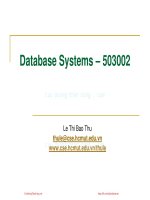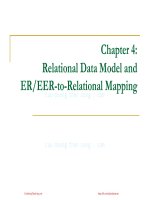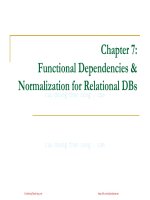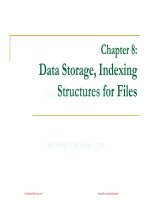cơ sở dữ liệu lê thị bảo thu chương ter c2 indexing structures for files sinhvienzone com
Bạn đang xem bản rút gọn của tài liệu. Xem và tải ngay bản đầy đủ của tài liệu tại đây (1.41 MB, 65 trang )
Chapter 2
Indexing Structures for Files
Adapted from the slides of “Fundamentals of Database Systems”
(Elmasri et al., 2011)
CuuDuongThanCong.com
/>
Chapter outline
Types of Single-level Ordered Indexes
Primary Indexes
Clustering Indexes
Secondary Indexes
Multilevel Indexes
Dynamic Multilevel Indexes Using B-Trees
and B+-Trees
Indexes in Oracle
CuuDuongThanCong.com
/>
2
Indexes as Access Paths
A single-level index is an auxiliary file that
makes it more efficient to search for a record in
the data file.
The index is usually specified on one field of the
file (although it could be specified on several
fields)
One form of an index is a file of entries
field value
The index is called an access path on the field.
CuuDuongThanCong.com
/>
3
Indexes as Access Paths (cont.)
The index file usually occupies considerably less
disk blocks than the data file because its entries
are much smaller.
A binary search on the index yields a pointer to
the file record.
Indexes can also be characterized as dense or
sparse:
A dense index has an index entry for every search key
value (and hence every record) in the data file.
A sparse (or nondense) index, on the other hand, has
index entries for only some of the search values
CuuDuongThanCong.com
/>
4
Example 1: Given the following data file:
EMPLOYEE(NAME, SSN, ADDRESS, JOB, SAL, ... )
Suppose that:
record size R=150 bytes
block size B=512 bytes
r=30000 records
SSN Field size VSSN=9 bytes, record pointer size PR=7 bytes
Then, we get:
blocking factor: bfr= B/R = 512/150 = 3 records/block
number of blocks needed for the file: b= r/bfr= 30000/3 = 10000 blocks
For an dense index on the SSN field:
index entry size: RI=(VSSN+ PR)=(9+7)=16 bytes
index blocking factor bfrI= B/RI = 512/16 = 32 entries/block
number of blocks for index file: bi= r/bfrI= (30000/32)= 938 blocks
binary search needs log2bi + 1 = log2938 + 1 = 11 block accesses
This is compared to an average linear search cost of:
(b/2)= 10000/2 = 5000 block accesses
If the file records are ordered, the binary search cost would be:
log2b = log210000 = 13 block accesses
CuuDuongThanCong.com
/>
5
Types of Single-level Ordered Indexes
Primary Indexes
Clustering Indexes
Secondary Indexes
CuuDuongThanCong.com
/>
6
Primary Index
Defined on an ordered data file.
One index entry for each block in the data file
The data file is ordered on a key field.
First record in the block, which is called the block anchor
A similar scheme can use the last record in a block.
CuuDuongThanCong.com
/>
7
Primary key field
ID
Name
DoB
Salary
Sex
1
2
Index file
(<K(i), P(i)> entries)
Primary
key value
Block
pointer
3
4
6
1
7
4
8
8
9
12
10
12
13
15
CuuDuongThanCong.com
/>
8
Primary Index
Number of index entries?
Dense or Nondense?
Number of blocks in data file.
Nondense
Search/ Insert/ Update/ Delete?
CuuDuongThanCong.com
/>
9
Clustering Index
Defined on an ordered data file.
The data file is ordered on a non-key field.
One index entry each distinct value of the field.
The index entry points to the first data block that
contains records with that field value
CuuDuongThanCong.com
/>
10
Clustering field
Dept_No
Name
DoB
Salary
Sex
1
1
Index file
(<K(i), P(i)> entries)
Clustering
field value
Block
pointer
2
2
2
2
1
2
2
3
3
4
3
5
4
4
5
CuuDuongThanCong.com
/>
11
Clustering field
Dept_No
Name
DoB
Salary
Sex
1
1
2
Index file
(<K(i), P(i)> entries)
2
2
2
Clustering
field value
Block
pointer
2
1
3
2
3
3
4
4
5
4
5
CuuDuongThanCong.com
/>
12
Clustering Index
Number of index entries?
Dense or Nondense?
Number of distinct indexing field values in data file.
Nondense
Search/ Insert/ Update/ Delete?
At most one primary index or one clustering
index but not both.
CuuDuongThanCong.com
/>
13
Secondary index
A secondary index provides a secondary means of
accessing a file.
Indexing field:
secondary key (unique value)
nonkey (duplicate values)
The index is an ordered file with two fields:
The data file is unordered on indexing field.
The first field: indexing field.
The second field: block pointer or record pointer.
There can be many secondary indexes for the same file.
CuuDuongThanCong.com
/>
14
Index file
(<K(i), P(i)> entries)
Index field
value
Secondary
key field
5
Block
pointer
13
3
8
4
5
6
6
15
8
3
9
9
11
…
13
21
11
15
18
4
21
23
23
18
Secondary index on key field
CuuDuongThanCong.com
/>
15
Secondary index on key field
Number of index entries?
Dense or Nondense?
Number of record in data file
Dense
Search/ Insert/ Update/ Delete?
CuuDuongThanCong.com
/>
16
Secondary index on non-key field
Discussion: Structure of Secondary index on nonkey field?
Option 1: include duplicate index entries with the
same K(i) value - one for each record.
Option 2: keep a list of pointers <P(i, 1), ..., P(i, k)>
in the index entry for K(i).
Option 3:
more commonly used.
one entry for each distinct index field value + an extra
level of indirection to handle the multiple pointers.
CuuDuongThanCong.com
/>
17
Secondary
Index on
non-key
field:
option 3
CuuDuongThanCong.com
/>
18
Secondary index on nonkey field
Number of index entries?
Number of records in data file
Number of distinct index field values
Dense or Nondense?
Dense/ nondense
Search/ Insert/ Update/ Delete?
CuuDuongThanCong.com
/>
19
Summary of Single-level indexes
Ordered file on indexing field?
Indexing field is Key?
Primary index
Clustering index
Primary index
Secondary index
Indexing field is not Key?
Clustering index
Secondary index
CuuDuongThanCong.com
/>
20
Summary of Single-level indexes
Dense index?
Secondary index
Nondense index?
Primary index
Clustering index
Secondary index
CuuDuongThanCong.com
/>
21
Summary of Single-level indexes
CuuDuongThanCong.com
/>
22
Chapter outline
Types of Single-level Ordered Indexes
Primary Indexes
Clustering Indexes
Secondary Indexes
Multilevel Indexes
Dynamic Multilevel Indexes Using B-Trees
and B+-Trees
Indexes in Oracle
CuuDuongThanCong.com
/>
23
Multi-Level Indexes
Because a single-level index is an ordered file, we
can create a primary index to the index itself.
The original index file is called the first-level index and the
index to the index is called the second-level index.
We can repeat the process, creating a third, fourth,
..., top level until all entries of the top level fit in
one disk block.
A multi-level index can be created for any type of
first-level index (primary, secondary, clustering) as
long as the first-level index consists of more than
one disk block.
CuuDuongThanCong.com
/>
24
A two-level primary
index resembling
ISAM (Indexed
Sequential Access
Method)
organization.
CuuDuongThanCong.com
/>
25









